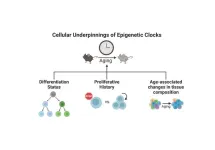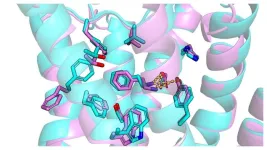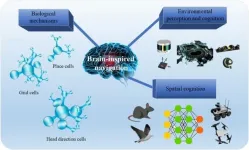(Press-News.org) Thyroid hormone plays a key role in regulating a range of physiologic functions, including metabolism, temperature, heart rate, and growth. It accomplishes this impressive array of activities by interacting with almost every organ system in the body. Yet despite a long history of research on how thyroid hormone influences different organs, its effects on arguably the most crucial organ — the brain — have remained shrouded in mystery.
Now, scientists at Harvard Medical School have gained new insights into thyroid hormone’s effects on the brain. The work, conducted in mice and published Aug. 22 in Cell, shows that thyroid hormone changes the wiring of brain circuits in a manner that drives animals to engage in exploratory behavior.
By simultaneously changing brain wiring and altering metabolic rate, the researchers concluded that thyroid hormone coordinates the brain and body to produce exploratory behavior when it is most needed — for example, during seasons when animals need to find mates or stockpile resources.
“It’s well known that thyroid hormone modulates metabolism, and now we’ve shown that it also modulates exploratory behaviors through direct action on the brain,” said lead author Daniel Hochbaum, research fellow in neurobiology in the Blavatnik Institute at HMS.
The findings also help elucidate how low levels of the hormone could lead to depressive states marked by a low desire to explore, while too much could precipitate manic states characterized by an extreme desire for exploration. Thus, the researchers see their work as an important step toward understanding how aberrant levels of thyroid hormone could contribute to certain psychiatric conditions.
Propelled by a personal purpose
Hochbaum’s interest in thyroid hormone is a personal one: His wife was diagnosed with hyperthyroidism after experiencing profound and sudden behavioral and metabolic changes. Her symptoms resolved with treatment, but Hochbaum wanted to know more about the hormone’s effects on the brain.
“I was really surprised to see that thyroid hormone had large psychiatric effects,” Hochbaum said.
He learned that too little thyroid hormone slows down metabolism and can result in symptoms of depression, while too much speeds up metabolism and can lead to symptoms of mania. Yet he couldn’t find a satisfactory scientific explanation for how this happens.
During a serendipitous conversation with Bernardo Sabatini, the Alice and Rodman W. Moorhead III Professor of Neurobiology at HMS, Hochbaum found that Sabatini shared his interest in the topic.
“Why thyroid hormone changes behavior has been something that’s puzzled me ever since medical school,” said Sabatini, who is also director of the Kempner Institute for the Study of Natural and Artificial Intelligence at Harvard University and senior author on the new study. “It was not clear why this hormone should even enter the brain at all.”
And with that, a project to explore thyroid hormone’s function in the brain was born.
Linking brain, body, and behavior
Thyroid hormone circulates in the bloodstream, traveling to almost every cell and tissue in the body. Its levels are controlled by a complex set of interactions between three players: the thyroid gland, the pituitary gland at the base of the brain, and the hypothalamus, a brain structure located just above the pituitary gland.
However, the receptor for thyroid hormone is expressed by cells throughout the entire brain, including in areas of the cortex responsible for high-level cognition like planning and decision-making.
“What is quite remarkable is that in the adult brain, the thyroid hormone receptor is not only in the hypothalamus, but it’s basically everywhere,” Hochbaum said.
To investigate why, Hochbaum, Sabatini, and their team performed genetic sequencing on individual cortical cells in mice. They found that the hormone acts on neuronal circuits in the cortex by turning on various genes, essentially changing the wiring of brain cells.
Moreover, when researchers induced higher levels of thyroid hormone in the cortex, mice became more willing to explore the environment and take risks.
Conversely, when researchers blocked the hormone’s action in only the cortex, the animals no longer changed how much they explored based on thyroid hormone levels.
“This told us that thyroid hormone is doing important things directly in the cortex,” Hochbaum said.
Yet the findings raised a new question: Why would it be beneficial for a hormone that controls metabolism to also alter brain circuits that affect behavior?
To address this question, the researchers turned to previously published field studies that observed behavior in the wild and measured thyroid hormone of lemurs, squirrel monkeys, and other mammals. The research revealed that hormone levels, and in turn metabolic rates, tended to be higher in warmer seasons when food and resources were more abundant — and animals explored more during those seasons.
The studies, combined with the new findings, Hochbaum said, provide an essential missing link between thyroid hormone’s effects on the brain and body.
“We think that thyroid hormone acts directly on brain circuits to coordinate exploratory behaviors with metabolic rate,” he added. “It’s syncing up your brain and body for the current environment.”
Or, as Sabatini put it, “It seems like thyroid hormone prompts the body to tell the brain to go explore and capture resources.”
Looking ahead
The way in which thyroid hormone regulates physiology is highly conserved between humans and other mammals, the researchers said, so they suspect that a similar brain-body connection exists in humans.
In fact, a 2024 study led by the same researchers linked higher thyroid hormone levels in U.S. adults to greater employment levels and more hours worked.
The researchers are now exploring this connection in people in Indonesia who experienced the 2004 tsunami. They are interested in whether psychological trauma from the natural disaster has led to long-term changes in thyroid hormone levels.
The team also wants to investigate the basic biology of the exploratory brain circuits that are activated by increased thyroid hormone. The researchers hope that their work could highlight brain circuits relevant to psychiatric conditions such as depression and bipolar disorder.
“The thought is that these conditions are also shaping exploratory activity, so perhaps manipulating thyroid hormone to change brain circuits will reveal relevant points of entry for treatment,” Hochbaum said.
Authorship, funding, disclosures
Additional authors on the paper include Alexandra Dubinsky, Hannah Farnsworth, Lauren Hulshof, Giona Kleinberg, Amanda Urke, Wengang Wang, Richard Hakim, Keira Robertson, Canaria Park, Alyssa Solberg, Yechan Yang, Caroline Baynard, Naeem Nadaf, Celia Beron, Allison Girasole, Lynne Chantranupong, Marissa Cortopassi, Shannon Prouty, Ludwig Geistlinger, Alexander Banks, Thomas Scanlan, Michael Greenberg, Gabriella Boulting, and Evan Macosko.
The research was supported by a Burroughs Wellcome Fund Career at the Scientific Interface Award, a Baszucki Brain Research Fund Bipolar Disorder Grant, a Blavatnik Biomedical Accelerator Grant, the Howard Hughes Medical Institute, and the National Institutes of Health (R37NS046579; T32GM144273).
END
How thyroid hormone fuels the drive to explore
Research in mice reveals previously unknown role for hormone in altering brain wiring to shape behavior
2024-08-22
ELSE PRESS RELEASES FROM THIS DATE:
Higher thiazide doses shown to reduce kidney stone events
2024-08-22
Higher thiazide doses are associated with greater reductions in urine calcium, which in turn correlate with fewer symptomatic kidney stone events, according to a Vanderbilt University Medical Center (VUMC) study published in JAMA Network Open.
Thiazide diuretics, commonly prescribed to prevent kidney stone recurrence, are drugs that act directly on the kidneys to promote diuresis (urine flow) by inhibiting the sodium/chloride cotransporter located in the distal convoluted tubule of a nephron ...
Reading your biological age in your blood or saliva? It’s not as simple as that
2024-08-22
How old are you, really? Your chronological age is the number of years you have been alive. Your biological age is how old your cells are which scientists believe may better assess one’s age-related health and disease risk. People biologically age at different rates, depending on genetic and environmental factors, so that a person’s chronological age does not necessarily match their biological age. In recent years, direct-to-consumer biological age tests have become increasingly accessible and popular as interest has increased ...
Pong prodigy: Hydrogel material shows unexpected learning abilities
2024-08-22
In a study published today (22 August) in Cell Reports Physical Science, a team led by Dr Yoshikatsu Hayashi demonstrated that a simple hydrogel - a type of soft, flexible material - can learn to play the simple 1970s computer game ‘Pong’. The hydrogel, interfaced with a computer simulation of the classic game via a custom-built multi-electrode array, showed improved performance over time.
Dr Hayashi, a biomedical engineer at the University of Reading’s School of Biological Sciences, said: "Our research shows that even very simple materials can exhibit complex, adaptive behaviours typically associated with living systems or sophisticated AI.
"This ...
AI can speed up drug development
2024-08-22
Artificial intelligence (AI) can help identify molecules that could serve as new drugs for mental health disorders. AI can be used to predict the three-dimensional structures of important receptors and thereby speed up the development of potential drugs. This is the result of a new study from Uppsala University published in Science Advances.
In drug development, experimental methods are often used to determine the three-dimensional structures of target proteins and to understand how molecules bind to them. This information is needed to design drug molecules efficiently. However, the process to determine structures can be demanding, meaning this ...
Bilateral reference framework for high-resolution dichotomous image segmentation
2024-08-22
A research team has developed a computer vision technique that can perform dichotomous image segmentation, high-resolution salient object detection, and concealed object detection in the same framework. Their novel bilateral reference framework (BiRefNet) is able to capture tiny-pixel features and holds potential for a wide range of practical computer vision applications.
The work is published in the journal CAAI Artificial Intelligence Research on August 22.
In computer vision research, ...
The future of robotics: Brain-inspired technologies paving the way
2024-08-22
In the ever-evolving field of robotics, a groundbreaking approach has emerged, revolutionizing how robots perceive, navigate, and interact with their environments. This new frontier, known as brain-inspired navigation technology, integrates insights from neuroscience into robotics, offering enhanced capabilities and efficiency.
Brain-inspired navigation technologies are not just a mere improvement over traditional methods; they represent a paradigm shift. By mimicking the neural mechanisms of animals, these technologies provide robots with the ability to navigate through complex and unknown terrains with unprecedented accuracy ...
IHME’s 2024 Roux Prize awarded to Community Health Impact Coalition CEO – recognized for contributions to improve population health
2024-08-22
On behalf of the Community Health Impact Coalition (CHIC), Dr. Madeleine Ballard, global health leader and CEO of CHIC, is the Institute for Health Metrics and Evaluation’s 2024 Roux Prize winner. The award recognizes Dr. Ballard’s work alongside thousands of community health workers (CHWs) to secure quality care for all, through evidence-based health systems benefiting millions of people across the world.
Half of the world's population lacks access to essential health services. Around the globe, CHWs have stepped up to address this critical gap and deliver care in a way that improves access, increases equity, and saves lives. Despite their ...
New detectable gravitational wave source from collapsing stars predicted from simulations
2024-08-22
The death of a massive, rapidly spinning star can shake the universe. And the resulting ripples — known as gravitational waves — could be felt by instruments on Earth, according to new research published August 22 in The Astrophysical Journal Letters. These new sources of gravitational waves just await discovery, the scientists behind the research predict.
The gravitational waves emerge following the violent deaths of rapidly rotating stars 15 to 20 times the mass of the sun. Upon running ...
New study examines use of opioids for chronic cough
2024-08-22
INDIANAPOLIS – Chronic cough, with symptoms lasting more than eight weeks, affects approximately one in 10 adults. Cough is among the most common reasons for seeking medical care in the United States, yet chronic cough is difficult to treat. One of the largest studies of chronic cough and one of the first to explore the use of opioids, which are known to suppress cough, to treat these patients, has found that 20 percent of patients with chronic cough received a prescription for a cough suppressant containing an opioid.
With the goals of estimating opioid prescription in the chronic cough population and of informing alternative treatment ...
SwRI develops novel methodology for measuring blood-brain barrier permeability
2024-08-22
SAN ANTONIO — August 22, 2024 —Scientists at Southwest Research Institute have developed a new screening method to identify drug formulations that can penetrate the blood-brain barrier (BBB), to facilitate treatment of brain diseases and conditions.
“The BBB protects the brain and central nervous system from potentially harmful substances in the bloodstream, regulating the transport of essential nutrients and ions while maintaining the stability of the central nervous system,” said Research Engineer Nicholas McMahon, from SwRI’s Bioengineering group. “However, the very characteristics that make the BBB such an ...
LAST 30 PRESS RELEASES:
Science briefing: An update on GLP-1 drugs for obesity
Lower doses of immunotherapy for skin cancer give better results
Why didn’t the senior citizen cross the road? Slower crossings may help people with reduced mobility
ASH 2025: Study suggests that a virtual program focusing on diet and exercise can help reduce side effects of lymphoma treatment
A sound defense: Noisy pupae puff away potential predators
Azacitidine–venetoclax combination outperforms standard care in acute myeloid leukemia patients eligible for intensive chemotherapy
Adding epcoritamab to standard second-line therapy improves follicular lymphoma outcomes
New findings support a chemo-free approach for treating Ph+ ALL
Non-covalent btki pirtobrutinib shows promise as frontline therapy for CLL/SLL
University of Cincinnati experts present research at annual hematology event
ASH 2025: Antibody therapy eradicates traces of multiple myeloma in preliminary trial
ASH 2025: AI uncovers how DNA architecture failures trigger blood cancer
ASH 2025: New study shows that patients can safely receive stem cell transplants from mismatched, unrelated donors
Protective regimen allows successful stem cell transplant even without close genetic match between donor and recipient
Continuous and fixed-duration treatments result in similar outcomes for CLL
Measurable residual disease shows strong potential as an early indicator of survival in patients with acute myeloid leukemia
Chemotherapy and radiation are comparable as pre-transplant conditioning for patients with b-acute lymphoblastic leukemia who have no measurable residual disease
Roughly one-third of families with children being treated for leukemia struggle to pay living expenses
Quality improvement project results in increased screening and treatment for iron deficiency in pregnancy
IV iron improves survival, increases hemoglobin in hospitalized patients with iron-deficiency anemia and an acute infection
Black patients with acute myeloid leukemia are younger at diagnosis and experience poorer survival outcomes than White patients
Emergency departments fall short on delivering timely treatment for sickle cell pain
Study shows no clear evidence of harm from hydroxyurea use during pregnancy
Long-term outlook is positive for most after hematopoietic cell transplant for sickle cell disease
Study offers real-world data on commercial implementation of gene therapies for sickle cell disease and beta thalassemia
Early results suggest exa-cel gene therapy works well in children
NTIDE: Disability employment holds steady after data hiatus
Social lives of viruses affect antiviral resistance
Dose of psilocybin, dash of rabies point to treatment for depression
Helping health care providers navigate social, political, and legal barriers to patient care
[Press-News.org] How thyroid hormone fuels the drive to exploreResearch in mice reveals previously unknown role for hormone in altering brain wiring to shape behavior






